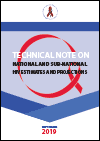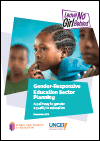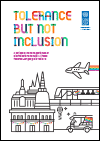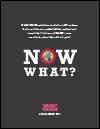What's New
Displaying results 931 - 940 of 4913

Resource | Publications,
HIV spending in Myanmar has been constantly increasing, reaching a record US$109.5 million in 2017, which represents a 21% increase of the 2016 amount (US$ 90.3 million). Public spending has increased both in absolute and in relative terms of the national HIV spending, increasing from 2% of total HIV funding in 2012 to 19% in 2017.
Despite this significant increase in public funding, the country depends largely on international funding to maintain its national HIV response, with international funds covering 80% of the national HIV spending in 2017 and being the main funding source for all HIV programmatic areas.

Resource | Publications,
National AIDS Spending Assessment (NASA) provides a framework and tools for undertaking a comprehensive analysis of actual HIV expenditures (health and non- health). It equips decision makers with strategic information that allow countries to mobilize resources and improve accountability mechanism for efficient and effective programme implementation. Between 2009-2015, Cambodia has conducted five rounds of NASA and this report summarizes the HIV expenditures for the period of 2016-2017.

Resource | Publications,
Cambodia has a rich and interesting history of HIV epidemic. First case of HIV was detected in 1991, that was 7 years after the first case identified in the neighboring Thailand, but epidemic escalates very quickly in Cambodia and by mid-1990s Cambodia became one of the fastest growing HIV epidemics in Asia. But Cambodia had successfully turned the epidemic around within 5 years after the epidemic had reached its peak and maintained its success in the past decade, resulting in 62% decline in new HIV infections between 2010 and 2018.1 Furthermore, the country is well publicized as one of the early achievers of 90-90-90 treatment targets in the global scale and these achievements have put the country under the spotlight in maintaining the success while accelerating the efforts to fill the response gaps.

Resource | Publications,
Education transforms lives. It is the surest investment to break down social and economic differences between people, unravel inequalities based on gender and accelerate progress towards the entire vision of the 2030 Agenda for Sustainable Development. Yet, despite the world’s commitment to ensure every child completes 12 years of quality education, in low-income countries only 4% of the poorest finish upper secondary school, falling to 2% amongst marginalised girls.

Resource | Publications,
These guidelines provide further reassurance of DTG as the preferred antiretroviral (ARV) drug in first- and second-line regimens due to the declining estimate of neural tube defect risk and observed efficacy. This reassurance comes at a time when pretreatment resistance to non-nucleoside reverse-transcriptase inhibitors (NNRTI) is increasing in low- and middle-income countries, creating demand for access to alternative non-NNRTI ARV drugs.

Resource | Publications,
The demonstrations sweeping across the world today signal that, despite unprecedented progress against poverty, hunger and disease, many societies are not working as they should. The connecting thread, is inequality.
Just as the gap in basic living standards is narrowing for millions of people, the necessities to thrive have evolved. A new generation of inequalities is opening up, around education, and around technology and climate change -- two seismic shifts that, unchecked, could trigger a ‘new great divergence’ in society of the kind not seen since the Industrial Revolution.
In countries with very high human development, for example, subscriptions to fixed broadband are growing 15 times faster and the proportion of adults with tertiary education is growing more than six times faster than in countries with low human development.
The report analyzes inequality in three steps: beyond income, beyond averages, and beyond today and proposes a battery of policy options to tackle it.

Resource | Publications,
This study is the most comprehensive ever conducted in Thailand examining the experiences of and social attitudes towards lesbian, gay, bisexual and transgender (LGBT) people. It involved a survey with 2,210 participants from across the country, including 1,349 LGBT people and 861 non-LGBT people, and focus group discussions in Bangkok, Chiang Mai, Phitsanulok and Pattani. The study found that there are overall favourable attitudes towards LGBT people in Thailand and significant support for inclusive laws and policies, but also persistent experiences of stigma and discrimination, violence and exclusion.

Resource | Publications,
The primary objective of the 2016-18 PNG DHS is to provide up-to-date estimates of basic demographic and health indicators. Specifically, the 2016-18 PNG DHS collected information on fertility, awareness, and use of family planning methods, breastfeeding practices, nutritional status of children, maternal and child health, childhood immunisation, adult and childhood mortality, women’s empowerment, domestic violence, malaria, awareness and behaviour regarding HIV/AIDS and other sexually transmitted infections (STIs), and other health-related issues.

Resource | Publications,
Each year, the AVAC Report frames the most pressing advocacy issues facing the HIV response. At the threshold of 2020, it’s clear that global goals for HIV prevention will miss the mark by a long shot. Though important progress has been made, the crisis UNAIDS called out in 2016 persists today with new infections around 1.7 million annually, a far cry from the 2020 target of fewer than 500,000. So, we asked ourselves, Now What?, and answered with cross-cutting analysis and an advocacy agenda to match.

Resource | Publications,
The 2018-19 Afghanistan Service Provision Assessment focused on tertiary/specialty and private hospitals. The assessment was conducted between November 2018 and January 2019. The overall goal of the survey was to gather information on the availability, readiness, and quality of health services in national specialty and provincial/regional hospitals, including major private sector hospitals in seven major urban areas (Kabul, Herat, Balkh, Kandahar, Nangarhar, Kunduz, Paktya). The assessment focused on specific service areas within the hospitals, which included family planning, maternal and child health, surgery, pediatrics, emergencies, intensive care, delivery, and newborn care. The findings will serve as a baseline for monitoring these services and progress over time.





